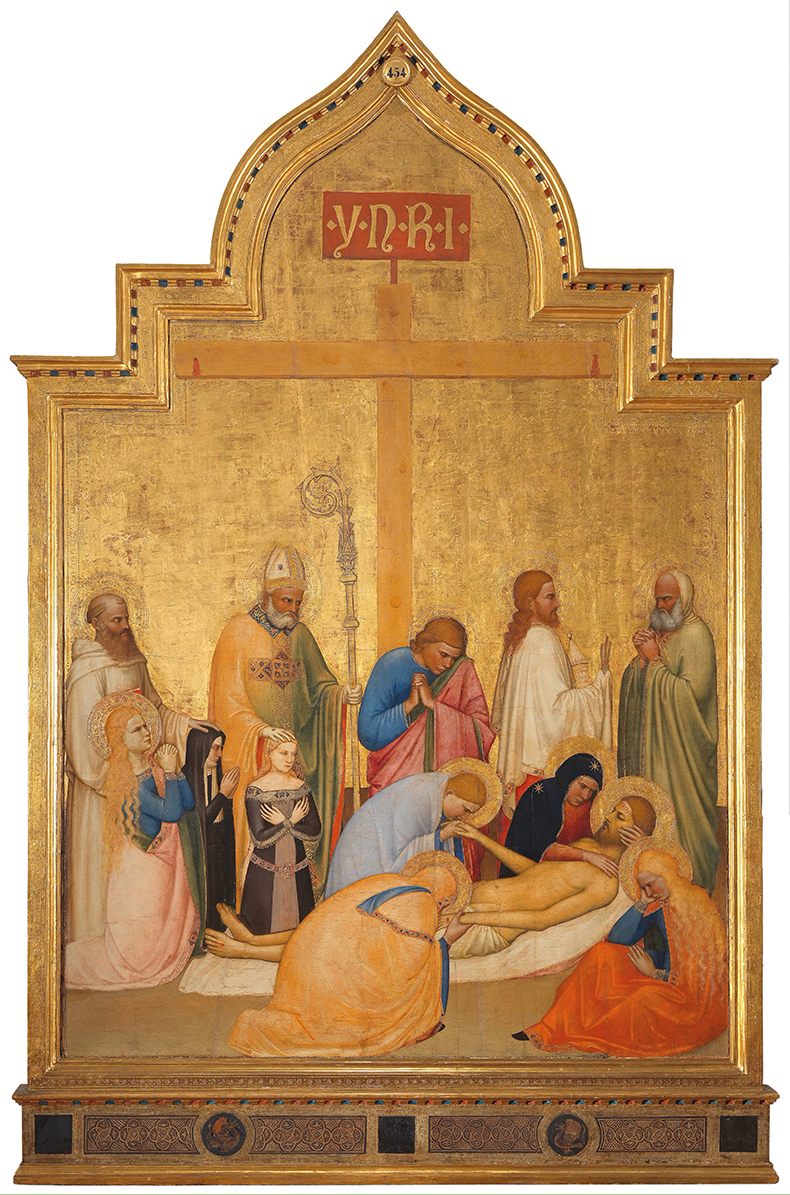From the June 2024 issue of Apollo. Preview and subscribe here.
Two of the artists name-checked in the subtitle of Christopher Wood’s ambitious new book on early Renaissance Italian painting – Giotto and Fra Angelico – will be familiar to a wide readership. The third, however, will come as a surprise. Not much is known about Giottino, or ‘little Giotto’, the nickname given to the son of the painter Stefano Fiorentino, one of the most talented of Giotto’s disciples according to early sources. The sculptor Lorenzo Ghiberti rated Stefano as ‘the best painter up to that time’, while Vasari judged Giottino’s art to have surpassed both his father’s and Giotto’s in its softness, diligence and unity. Almost none of the works that early modern writers ascribed to Giottino and his father survive, and their imprint on the archival record is similarly slight, leaving a problematic gap in our understanding of Giotto’s legacy in the middle decades of the 14th century.
Giottino’s reputation today rests above all on the extraordinary Lamentation over the Dead Christ painted in the 1350s or ’60s for the Florentine parish church of San Remigio (and now in the Uffizi). Two contemporary figures – both women, one veiled, the other fashionably dressed – kneel amid the sacred drama. They provide Wood with the central case study for his book’s leitmotif, the ‘embedded portrait’ – images of modern supplicants sharing space with holy narratives. Giottino’s Lamentation certainly deserves its moment in the limelight, and Wood acutely guides the reader through the subtle blendings and iconographic doublings that knit the painting together. The 14th-century trespassers, ‘metabolised by style, disappear into the painting’. Even so, the two women ‘just don’t belong’, and – furthermore – ‘their non-belonging is the content of the picture’.
For Wood, Giottino’s panel is a turning point within a much longer and more consequential narrative. Drawing on examples from across the 14th and 15th centuries, he argues that the intrusion of donor figures placed growing pressure on medieval traditions of religious art, as artists devised new means to insert patrons into sacred scenes. The process is already apparent in Giotto’s work; the book opens with that artist’s Crucifixion in Munich. After Giottino, it would accelerate in the 15th century with the realism facilitated by oils provoking a tension between patron and artist that would ultimately be settled in the latter’s favour. Embedded portraits would gradually disappear in later centuries. In this sense the book echoes Hans Belting, Victor Stoichita, and Wood’s own work with Alexander Nagel in its concern with epochal shifts in painting between the Middle Ages and modernity.
Lamentation over the Dead Christ (c. 1350–55 or after 1363), Giottino (c. 1324–c. 72). Gallerie degli Uffizi, Florence

This crass summary does poor justice to the exceptional breadth of learning and conceptual curiosity on display here, at times demanding but always stimulating. As one would expect from an art historian so steeped in the study of his discipline and its German-language historiography, Riegl, Warburg and Panofsky all feature prominently, along with a substantial digression on Hegel. Wood finds fewer intellectual soulmates among more recent generations of art historians (T.J. Clark is a notable exception). Instead, The Embedded Portrait casts a wider net to expand its theoretical arsenal, enlisting cognitive science to rethink chains of imitation and psychoanalytic literary theory to forge a fresh art-historical perspective on pre-modern sacred art.
Readers who were disappointed that Wood, in his magisterial survey A History of Art History (2019), ended with John Berger will be interested in the author’s thoughts on what he calls the ‘millennial style’ of art history (see November 2019 issue of Apollo). Wood is sceptical of – or at least sets himself apart from – the anthropological and sociological turns that mark much current work on late medieval and Renaissance art, what he characterises as the ‘behaviourist’ approach (the current reviewer finds himself in a list of practitioners). Wood is concerned that art historians of these periods have effectively merged themselves into social and religious history. The functionalist trend inaugurated by Belting’s The Image and its Public in the Middle Ages (1981) comes in for similar critique, although Wood includes a warm acknowledgement of his debt to Belting, who taught him at Harvard as a graduate student. He defines his own book as a ‘counter project’ to Belting’s and ‘counter-cyclical in disciplinary terms’.
For Wood, ‘histories of piety cannot be extricated from biographies of artistic form’. The book mirrors this approach. Paintings and artworks are generally reproduced as stand-alone, enframed plates. With one exception – a general interior view of San Remigio – there are no contextual images (nor any ground plans or montages of now fragmented altarpieces). This is art history as shaped by the library and fototeca rather than the church interior, conservation studio or archive.
At one point Wood has to descend to the nitty-gritty of what was where in San Remigio, when he proposes an Annunciation attributed to Jacopo di Cione now in Ponce, Puerto Rico, as the pendant panel for Giottino’s Lamentation that Vasari saw. In the Ponce painting an obtrusive donor figure kneels between Gabriel and the Virgin, but the picture requires further study and lacks either an early provenance or recent technical analysis. The hypothesis also means discounting another Annunciation apparently signed by Orcagna which most Italian scholars identify with the panel mentioned by Vasari. This second Annunciation presents its own challenges, as no one has seen the painting since 1960 and even its dimensions are in doubt. Wood thinks it may be a fake, but Miklos Boskovits – the finest trecento connoisseur of his generation – was convinced it was genuine. Hopefully the panel will bob to the surface of the art market one day. In which case, perhaps fittingly, the picture will decide the argument. But for now, there is much to enjoy in Wood’s wide-ranging foray into the scholarship of early Renaissance Italian painting, which is sure to shake up the field.
The Embedded Portrait: Giotto, Giottino, Angelico by Christopher Wood is published by Princeton University Press.
From the June 2024 issue of Apollo. Preview and subscribe here.



